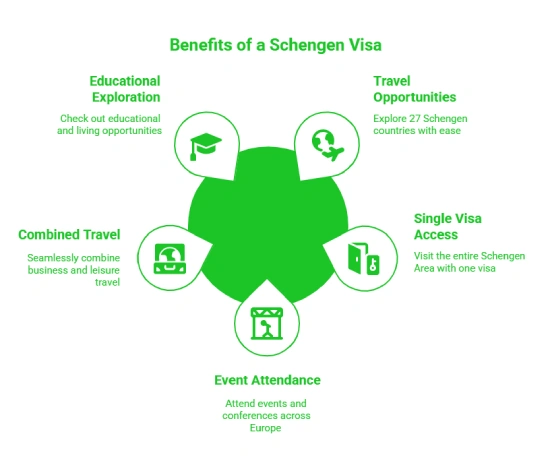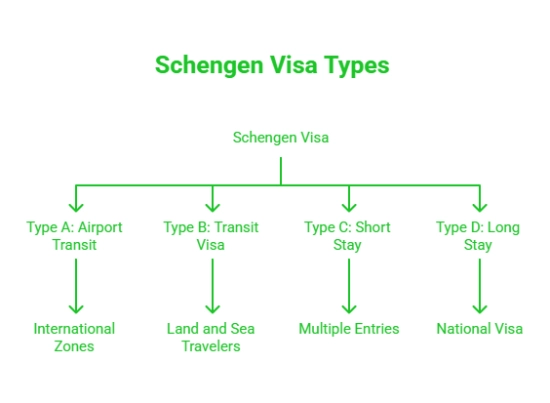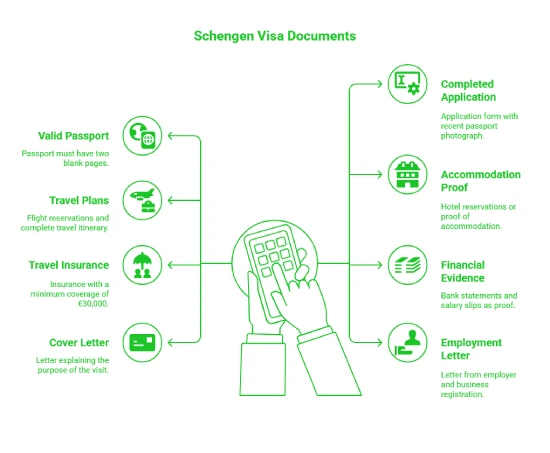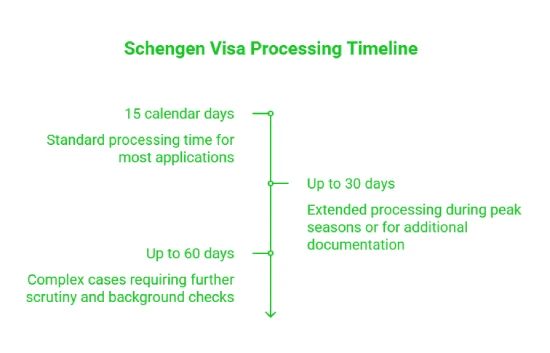A Schengen Visa you gives you access to all 27 European countries which operate under this single visa system. The Schengen Visa simplifies cross-border travel and saves both time and money for people who need to visit European countries for vacation business or family trips.
A Schengen Visa is a short-stay permit allowing non-EU travelers to visit any of the 27 Schengen countries for up to 90 days within a 180-day period. This single visa enables free movement across internal borders of member states.
The Schengen area has 29 countries that maintain their own rules, policies, and visa application timelines.
The table below has the list of Schengen visa countries:
| Austria | Liechtenstein |
| Belgium | Lithuania |
| Bulgaria | Luxembourg |
| Croatia | Malta |
| The Czech Republic | The Netherlands |
| Denmark | Norway |
| Estonia | Poland |
| Finland | Portugal |
| France | Romania |
| Germany | Slovakia |
| Greece | Slovenia |
| Hungary | Spain |
| Iceland | Sweden |
| Italy | Switzerland |
| Latvia | |
You must apply for a Schengen Visa if you are a citizen of a visa-required country, such as India. Even if you hold long-term residence in a visa-exempt country, you still need a visa. Only citizens from visa-exempt nations (e.g., U.S., UK, Canada) using an eTA or ETIAS do not require it.

Schengen Visas come in different forms according to their purpose and duration of stay. Schengen Visas divide their classification based on the travel purpose and time duration, which leads to multiple categories.
This visa provides travel clearance to individuals passing through the Schengen Airport international zones.
Type B Visa serves as a transit visa for land and sea travelers who can stay up to 5 days in the Schengen Area. Current usage statistics show its decline, although some countries continue to follow this visa type in their documentation.
This visa category serves as the standard visa for travelers who want to visit the Schengen Area for periods of up to 90 days. The multiple-entry system allows travelers to use their visas for more than one visit.
The Type D Schengen visa permits travelers to stay in one Schengen country for more than 90 days. The visa holder can also visit other Schengen states during the 180-day period for up to 90 days. The national visa gets issued through the embassies of each country.

You can make a Schengen Visa application if:
Individuals who apply for a Schengen visa must provide the following requirements:
| Factor | Schengen Visa (Type C) | National Visa (Type D) |
| Purpose | Short-term stay (tourism, business, family visit, transit) | Long-term stay (work, study, family reunification) |
| Duration | Up to 90 days within a 180-day period | More than 90 days |
| Validity | Valid across all 27 Schengen countries | Valid only in the issuing country |
| Number of Entries | Single, double, or multiple entry | Usually single entry; long-stay residence permit follows |
| Application Authority | Embassy/consulate of main destination or first-entry country | Embassy/consulate of the specific country of long-term stay |
| Biometrics Required | Yes | Yes |
| Work Permission | Not allowed | May allow work depending on the visa type (e.g., work permit) |

Step 1: Identify the visa type
Identify the Schengen country where you will spend the most time or first enter, and apply through its embassy or consulate.
Step 2: Book an appointment
Your first step involves booking a visa appointment at the admission office, consulate, or visa application centre (e.g., VFS Global or BLS International).
Step 3: Complete the visa application form
Accurately fill in the official Schengen Visa application form. Multiple consulates provide online applications that you can also download.
Step 4: Prepare your documents
You need to collect all necessary documents, including passport, photographs, travel insurance, proof of funds, flight itinerary, accommodation proof, and a cover letter.
Step 5: Attend the visa appointment
You must go to the scheduled appointment to submit your application along with biometric data and payment of the visa fee.
Step 6: Wait for processing
The standard time frame for visa processing is 15 calendar days, yet it can take 30 or 45 days in specific situations.
Step 7: Collect your passport
After your application process concludes, you can either pick up your passport in person or wait for it to be delivered by courier through the visa centre service.
The Schengen visa processing procedure, which consists of appointment booking until visa stamping, generally requires between 2 weeks and 4 weeks. The processing duration depends on how busy the consulate i,s together with the thoroughness of submitted documents, as well as the applicant's profile. Getting your application in early secures better odds for receiving your visa approval on time.
The table below has complete details of the Schengen visa fees:
| Applicant Category | Visa Fee (EUR) |
| Adults | € 80 |
| Children (6–12 years) | € 40 |
| Children under 6 | Free |
| Nationals of select countries | Reduced/waived |
The processing time for a Schengen Visa typically depends on several factors, including the applicant's nationality, the specific embassy or consulate handling the application, the time of year, and the completeness of the submitted documents.
Standard Processing Time
Extended Processing Times

| Factor | Schengen Visa (Type C) | National Visa (Type D) |
| Purpose | Short-term stay (tourism, business, family visit, transit) | Long-term stay (work, study, family reunification) |
| Duration | Up to 90 days within a 180-day period | More than 90 days |
| Validity | Valid across all 27 Schengen countries | Valid only in the issuing country |
| Number of Entries | Single, double, or multiple entry | Usually single entry; long-stay residence permit follows |
| Application Authority | Embassy/consulate of main destination or first-entry country | Embassy/consulate of the specific country of long-term stay |
| Biometrics Required | Yes | Yes |
| Work Permission | Not allowed | May allow work depending on the visa type (e.g., work permit) |
Y-Axis identifies the best strategy for a successful visa application.
Y-Axis has the knowledge and experience to guide you in the visa application procedure.
Explore what Global Citizens have to say about Y-Axis in shaping their future
Schengen Visa
One of our clients has applied for Denma
Read More...
Schengen Visa
Y-Axis Client Mr.Kinu applied for Scheng
Read More...
Schengen Visa
Y-Axis Client Review that he applied for
Read More...
Yes, a Schengen visa can be applied online as many Schengen countries provide online visa form submission through their embassy and consulate websites. The submission of documents and biometric data requires a physical visit to a visa application centre such as VFS Global or BLS International. The application systems of France and Germany currently include e-forms and e-appointment booking while Schengen short-stay visas do not have full online processing for e-visa issuance yet. Always confirm the correct procedure through the embassy's official website for your specific region.
The Schengen Visa enables its holder to move around 27 European countries within the Schengen Area using one visa only. A single visa provides permission to stay for 90 days within any 180-day period. The number of Schengen countries you can visit depends on the particular visa type you receive (single, double or multiple entry). The application process requires you to submit your documents to either the main destination consulate or the first entry country. The visa serves exclusively for tourism and business travel as well as family visits and it prohibits employment.
The current Schengen Visa application fee stands at €80 for adults and €40 for children between 6 and 12 years old as of 2024. The application fee does not apply to children under six years of age. Nationals of some countries have the opportunity to receive payment discounts because of established bilateral agreements. The payment for visa expenses typically occurs during the visa application appointment through local currency transactions.
A typical Schengen Visa provides 90 days of validity within a 180-day period starting from the first entry date. The actual visa duration depends on the assessment of the visa officer who considers your previous travel history alongside your current itinerary. Multiple-entry visas receive between 1 and 5 years of validity yet they must abide by the 90-day-in-180-day rule for each visit. The visa sticker contains explicit information about both its duration and the time you can spend in the Schengen Area. If you stay beyond your authorized time the authorities may issue a ban.
The Schengen Area includes 29 countries in Europe that have abolished internal borders for unrestricted movement. These include popular destinations like France, Germany, Italy, Spain, Switzerland, and the Netherlands. The Schengen Visa allows travel to all these countries without requiring separate visas, making it ideal for multi-country European trips. However, countries like Ireland, Cyprus, and Romania, while in the EU, are not part of Schengen.
The list of countries included in the Schengen area are as follows:
The Schengen Visa application process requires you to visit either the embassy or consulate or official visa centre of your main destination or first entry country. The visa application requires a scheduled appointment for submitting your documents in person. The documentation requirements and application procedures differ slightly according to each country so you should check the official embassy website for your area. Apply long before your departure date particularly during busy periods.
Lithuania, Estonia, and Finland are the three nations from Canada that tend to approve Schengen Visa applications at high rates and process paperwork quickly. Canadian cities offer efficient visa processing through VFS Global for France, Spain, and Italy because these countries receive higher travel demand from Canada. Visa approval depends on more than just the chosen country since applicant documentation alongside travel history and visit purpose also play important roles. Regardless of the country the application quality directly affects the approval chances.
The standard time required for processing a Schengen Visa application extends to 15 calendar days starting from the day when authorities receive your documents. The processing duration can extend to 30 days or even 60 days in some instances particularly during high-travel seasons or when extra verification becomes necessary. Applications should be submitted at least 4 weeks ahead of time because the application period begins 6 months before the planned travel date. The time required for processing includes document verification along with biometric checks and either courier delivery or personal pickup of the passport.
The necessary documents for a Schengen Visa include:
| Feature | Schengen Visa | Tourist Visa (Non-Schengen) |
| Purpose | Short-term travel across multiple European countries | Travel to a specific country for tourism |
| Coverage | 27 Schengen countries | Only one country (e.g., USA, Canada, UK) |
| Type | Type C (Short-stay visa) | Varies by country (e.g., B2 for USA, TRV for Canada) |
| Validity | Up to 90 days within 180-day period | Typically 30 to 180 days, depending on country |
| Entry Options | Single, Double, or Multiple Entry | Typically Single or Multiple Entry |
| Travel Insurance Requirement | Mandatory (€30,000 coverage minimum) | Usually required, terms vary by country |
| Application Location | Embassy/Consulate of main destination or first entry | Embassy/Consulate of the country you wish to visit |
| Use Case | Ideal for multi-country European trips | Ideal for single-country leisure visits |